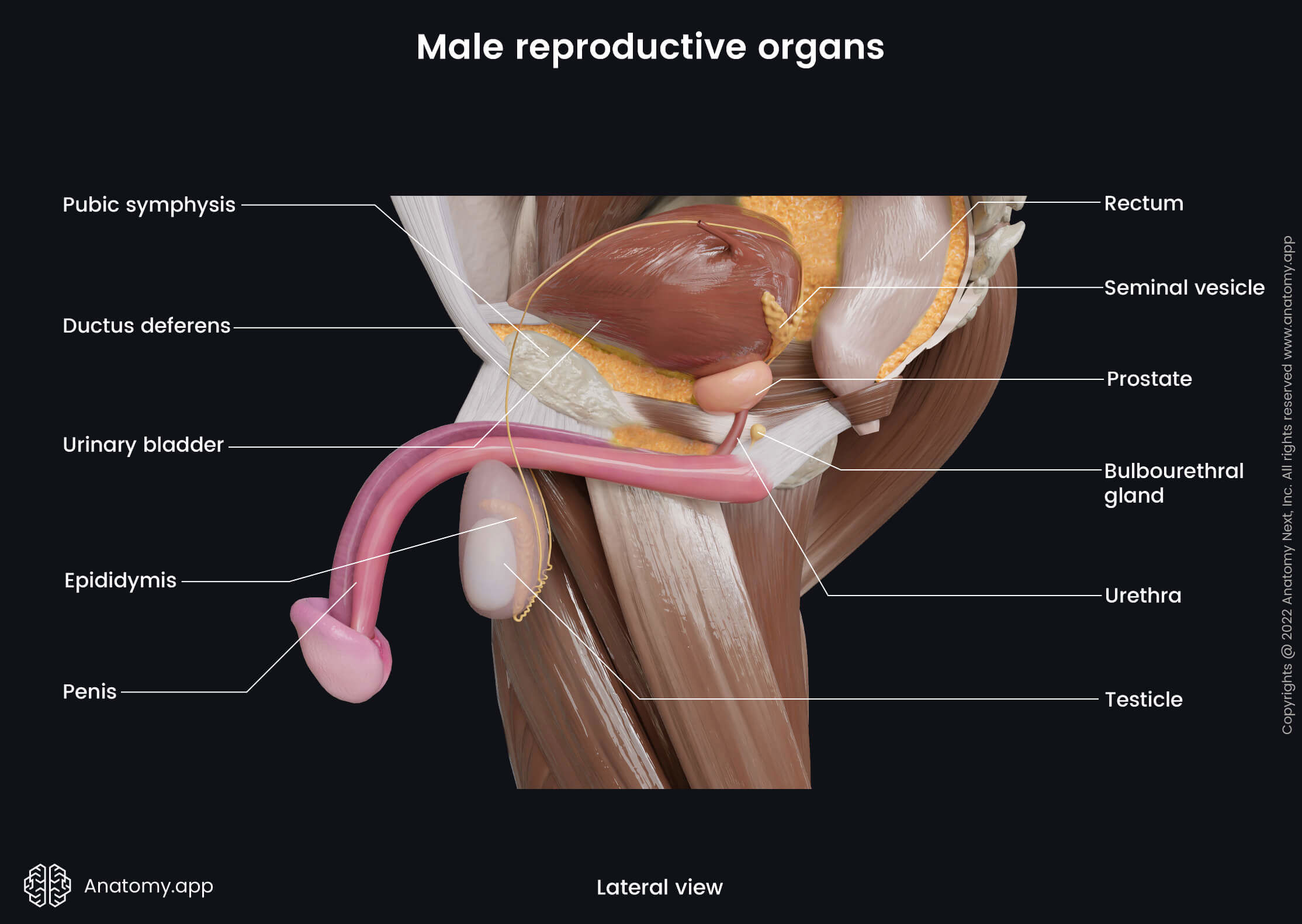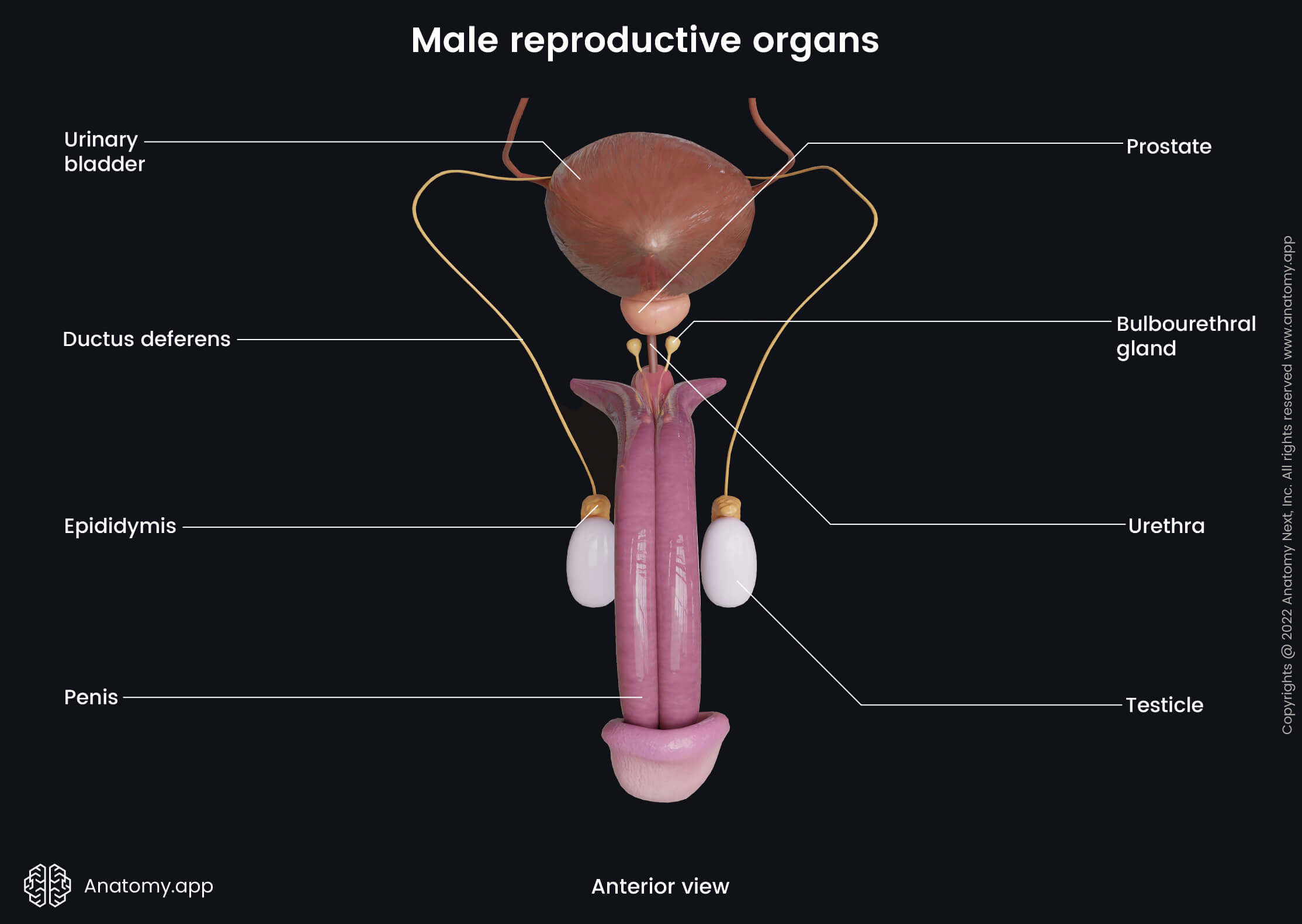Male reproductive system (overview)
The male reproductive system is composed of various organs, glands and ducts that all work together to produce, store, and deliver sperm, which can fertilize the female egg and, ultimately, produce offspring. These organs are also responsible for giving sexual pleasure, and some of them produce essential male sex hormones called androgens that are responsible for male development.
Overall, the male reproductive organs can be subdivided into two groups - internal and external genital organs. As the names suggest, the internal genital organs are found within the male body, while the external genital organs are found outside the male body.
The internal male genital organs include the following organs and structures:
- Testicle (testis) (Read more!) - two small, oval-shaped organs that are found within the scrotum; they produce sperm and are responsible for the synthesis of the male sex hormone testosterone; each testicle is surrounded by several layers of tissue;
- Epididymis (Read more!) - a long and coiled tube-like structure that lies on the upper and posterior aspects of the testicle; it is a paired structure that is composed of a series of ducts; epididymis serves as a site where spermatozoa mature and are stored;
- Ductus deferens (Read more!) - a long paired muscular tube that carries sperm from the epididymis to the ejaculatory duct; the distal end of the ductus deferens is slightly dilated, and this enlargement is known as ampulla; each ampulla converges with the excretory duct of the seminal vesicle to form the ejaculatory duct;
- Seminal vesicle (Read more!) - two small elongated and tube-like glands that are located posterior to the prostate and inferior to the fundus of the bladder; they produce a fluid that nourishes and protects sperm and forms the majority of the semen;
- Prostate (Read more!) - a small unpaired gland that is located inferior to the bladder; it surrounds the urethra; it produces a thin, milky fluid that also participates in the formation of the semen; overall, the fluid produced by the prostate contains various substances that help nourish and protect sperm;
- Ejaculatory duct - a pair of short, muscular tubes that connect the ductus deferens to the urethra; this duct goes through the prostate and joins the urethra close to the apex of the gland; these ducts are responsible for propelling sperm and seminal fluid into the urethra during ejaculation;
- Bulbourethral gland (Cowper's gland) (Read more!) - two small pea-shaped glands located behind the membranous portion of the urethra inferior to the prostate and near the root of the penis; it produces a fluid that lubricates the urethra and helps to neutralize any acidity in the urethra.

The external genital organs of the male are as follows:
- Penis (Read more!) - an unpaired organ responsible for the excretion of urine and sperm;
- Scrotum - a sac of skin and smooth muscles that holds the paired testicles, epididymides, and the lower portions of the spermatic cords; it is located below the penis and is divided into two compartments, each of which contains one testicle and epididymis; the scrotum helps to regulate the temperature of the testicles, which is an important physical factor that can affect sperm production.

Functions of male reproductive system
The male reproductive system is primarily responsible for producing and delivering sperm. The testicles produce millions of sperm daily, which are then stored and matured in the epididymis.
When a man becomes sexually aroused, the muscles surrounding the epididymis and ductus deferens contract, forcing sperm into the ejaculatory duct. The seminal vesicles, prostate and bulbourethral glands produce fluids that mix with sperm, creating semen. The semen is further ejaculated out of the body during orgasm via the urethra that goes through the penis.
Overall, the male reproductive organs serve several essential functions, and here is a summary of some of the key functions:
- Production of sperm - the testes are responsible for producing sperm; the process of sperm production is called spermatogenesis;
- Storage and transportation of sperm - the epididymis serves to store and transport sperm from the testicle to the ductus deferens; further sperm is transported to the outside of the body via the ductus deferens, ejaculatory duct and urethra;
- Production of semen - various sex glands, including the seminal vesicles, prostate, and bulbourethral glands, produce and secrete fluids that combine with sperm to form semen; these fluids contain nutrients that nourish sperm and help spermatozoa to survive in the female reproductive tract;
- Ejaculation - the process of ejaculation involves the contraction of muscles in the male reproductive system, which propels semen out of the body through the urethra;
- Sexual pleasure function - the male reproductive system plays a crucial role in sexual function, including arousal, erection, and orgasm;
- Secretion of hormones - the testicles also secrete male sex hormones such as testosterone; it plays a crucial role in the development of male secondary sexual characteristics - facial and body hair growth, deepening of the voice, and muscle mass enlargement.
To sum up, the male reproductive system is essential for the continuation of the human species, as it enables men to produce and deliver sperm for fertilization of the female egg.